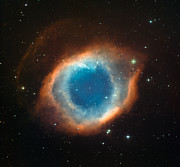Nota de prensa
HACIA EL OJO DE HELIX
25 de Febrero de 2009
Una nueva imagen profunda de la magnífica nebulosa planetaria Helix se obtuvo empleando el Wide Field Imager del Observatorio La Silla de ESO. A pesar de una exposición relativamente corta, la imagen muestra un rico trasfondo de galaxias distantes que generalmente no son visibles en otras fotografías de este objeto.
La nebulosa Helix, NGC 7293, queda a alrededor de 700 años-luz de distancia, en la constelación de Acuario. Es uno de los ejemplos más cercanos y más espectacular de una nebulosa planetaria. Estos objetos exóticos no tienen nada que ver con planetas, sino que son el último florecer de estrellas semejantes al Sol antes de su retiro final como enanas blancas. Capas de gas son expulsadas desde la superficie de la estrella, a menudo en patrones complejos y bellos, y brillan bajo la radiación ultravioleta emitida por la tenue pero muy calurosa estrella central. El anillo principal de la nebulosa Helix mide alrededor de dos años-luz de ancho, equivalente a la mitad de la distancia que hay entre el Sol y su vecino estelar más cercano.
A pesar de ser fotográficamente muy espectacular, Helix es difícil de observar en luz visible ya que su luz está finamente dispersa a lo largo de una gran área del cielo y la historia de su descubrimiento es un tanto oscura. Aparece por primera vez en un listado de objetos nuevos compilado por el astrónomo alemán Karl Ludwig Harding en 1824. El nombre Helix proviene de las primeras observaciones que revelaban la forma de un tosco tirabuzón.
Aunque Helix se parece mucho a una rosquilla, los estudios han mostrado que posiblemente está formada por al menos dos discos separados con anillos y filamentos externos. El disco interior más brillante parece estar expandiéndose a unos 100.000 km/h y habría demorado alrededor de 12.000 años en formarse. Una mirada cuidadosa a su parte central revela no sólo los nódulos sino también muchas galaxias remotas que se ven a través del gas brillante finamente extendido. Algunas de ellas parecen estar reunidas en grupos de galaxias separados, que se esparcen a través de varias partes de la fotografía, como por ejemplo, alrededor de la enana blanca central.
Debido a que Helix está relativamente cerca -cubre un área del cielo cercana a la cuarta parte de la Luna llena-, puede ser estudiada en mucho mayor detalle que la mayoría de otras nebulosas planetarias y se ha descubierto que tiene una estructura inesperada y compleja. Todo lo que rodea el interior del anillo son pequeñas formaciones, conocidas como “nódulos cometarios”, con tenues colas que se extienden a partir de la estrella central. Se parecen mucho a pequeñas gotas de líquido escurriendo por un vidrio. A pesar de que se ven pequeños, cada nódulo es casi del tamaño de nuestro Sistema Solar. Estos nódulos han sido extensamente estudiados, tanto con el Very Large Telescope de ESO como con el Telescopio Espacial Hubble de NASA/ESA, pero aún son sólo parcialmente comprendidos.
Enlaces
- Artículo sobre observaciones anteriores del VLT en el ESO Messenger (inglés)
- Observaciones anteriores de Hubble (inglés)
Contactos
Henri Boffin
ESO
Garching, Germany
Teléfono: +49 89 3200 6222
Correo electrónico: hboffin@eso.org
Valentina Rodriguez
ESO
Chile
Teléfono: +56 2 463 3123
Correo electrónico: vrodrigu@eso.org
José Miguel Mas Hesse (Contacto para medios de comunicación en España)
Red de Difusión Científica de ESO
y Centro de Astrobiología (CSIC-INTA)
Madrid, Spain
Teléfono: +34 918131196
Correo electrónico: eson-spain@eso.org
Acerca de la nota de prensa
| Nota de prensa No.: | eso0907-es |
| Legacy ID: | PR 07/09 |
| Nombre: | Helix Nebula, NGC 7293 |
| Tipo: | Milky Way : Nebula : Type : Planetary |
| Facility: | MPG/ESO 2.2-metre telescope |
| Instruments: | WFI |
Our use of Cookies
We use cookies that are essential for accessing our websites and using our services. We also use cookies to analyse, measure and improve our websites’ performance, to enable content sharing via social media and to display media content hosted on third-party platforms.
ESO Cookies Policy
The European Organisation for Astronomical Research in the Southern Hemisphere (ESO) is the pre-eminent intergovernmental science and technology organisation in astronomy. It carries out an ambitious programme focused on the design, construction and operation of powerful ground-based observing facilities for astronomy.
This Cookies Policy is intended to provide clarity by outlining the cookies used on the ESO public websites, their functions, the options you have for controlling them, and the ways you can contact us for additional details.
What are cookies?
Cookies are small pieces of data stored on your device by websites you visit. They serve various purposes, such as remembering login credentials and preferences and enhance your browsing experience.
Categories of cookies we use
Essential cookies (always active): These cookies are strictly necessary for the proper functioning of our website. Without these cookies, the website cannot operate correctly, and certain services, such as logging in or accessing secure areas, may not be available; because they are essential for the website’s operation, they cannot be disabled.
Functional Cookies: These cookies enhance your browsing experience by enabling additional features and personalization, such as remembering your preferences and settings. While not strictly necessary for the website to function, they improve usability and convenience; these cookies are only placed if you provide your consent.
Analytics cookies: These cookies collect information about how visitors interact with our website, such as which pages are visited most often and how users navigate the site. This data helps us improve website performance, optimize content, and enhance the user experience; these cookies are only placed if you provide your consent. We use the following analytics cookies.
Matomo Cookies:
This website uses Matomo (formerly Piwik), an open source software which enables the statistical analysis of website visits. Matomo uses cookies (text files) which are saved on your computer and which allow us to analyze how you use our website. The website user information generated by the cookies will only be saved on the servers of our IT Department. We use this information to analyze www.eso.org visits and to prepare reports on website activities. These data will not be disclosed to third parties.
On behalf of ESO, Matomo will use this information for the purpose of evaluating your use of the website, compiling reports on website activity and providing other services relating to website activity and internet usage.
Matomo cookies settings:
Additional Third-party cookies on ESO websites: some of our pages display content from external providers, e.g. YouTube.
Such third-party services are outside of ESO control and may, at any time, change their terms of service, use of cookies, etc.
YouTube: Some videos on the ESO website are embedded from ESO’s official YouTube channel. We have enabled YouTube’s privacy-enhanced mode, meaning that no cookies are set unless the user actively clicks on the video to play it. Additionally, in this mode, YouTube does not store any personally identifiable cookie data for embedded video playbacks. For more details, please refer to YouTube’s embedding videos information page.
Cookies can also be classified based on the following elements.
Regarding the domain, there are:
- First-party cookies, set by the website you are currently visiting. They are stored by the same domain that you are browsing and are used to enhance your experience on that site;
- Third-party cookies, set by a domain other than the one you are currently visiting.
As for their duration, cookies can be:
- Browser-session cookies, which are deleted when the user closes the browser;
- Stored cookies, which stay on the user's device for a predetermined period of time.
How to manage cookies
Cookie settings: You can modify your cookie choices for the ESO webpages at any time by clicking on the link Cookie settings at the bottom of any page.
In your browser: If you wish to delete cookies or instruct your browser to delete or block cookies by default, please visit the help pages of your browser:
Please be aware that if you delete or decline cookies, certain functionalities of our website may be not be available and your browsing experience may be affected.
You can set most browsers to prevent any cookies being placed on your device, but you may then have to manually adjust some preferences every time you visit a site/page. And some services and functionalities may not work properly at all (e.g. profile logging-in, shop check out).
Updates to the ESO Cookies Policy
The ESO Cookies Policy may be subject to future updates, which will be made available on this page.
Additional information
For any queries related to cookies, please contact: pdprATesoDOTorg.
As ESO public webpages are managed by our Department of Communication, your questions will be dealt with the support of the said Department.






